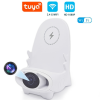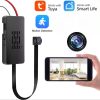Useful
PoE monitoring vs ordinary network cable monitoring: the influence of technical differences and camera size
With the increasing demand for security, the choice of monitoring system has become the focus of users’ attention. Among them, the comparison between PoE(Power over Ethernet) monitoring and traditional network cable monitoring, and the influence of camera size on performance are common puzzles. This paper will analyze the technical principle, practical application and camera design to help users make more informed choices.
First, the core difference between PoE monitoring and ordinary network cable monitoring
1. Power supply mode
PoE monitoring: data and power are transmitted simultaneously through a single network cable, which conforms to the IEEE 802.3af/at standard and supports up to 30W power supply (802.3at).
Ordinary network cable monitoring: data is only transmitted through the network cable, and the camera needs to be connected with an additional power adapter or independent power cord.
2. Wiring complexity
PoE: It simplifies wiring and does not need to deploy a separate power cord, especially suitable for ceiling, outdoor and other scenes where it is difficult to distribute electricity.
Ordinary network cable: it is necessary to lay network cable and power cord at the same time, which will increase the construction cost and failure risk (such as loose power cord).
3. Cost and scalability
PoE: The initial cost is high (the switch or injector supporting PoE is required), but it is flexible to expand. The new camera only needs to be connected to the PoE switch.
Ordinary network cable: the equipment cost is low, but the location of power socket should be considered when expanding, so it is difficult to transform.
4. Transmission distance and stability
PoE: the standard transmission distance is 100 meters, which exceeds the need for repeaters; The same cable for power and data may introduce interference (shielded network cable is required).
Ordinary network cable: the data transmission distance is 100 meters, and the long power cable may lead to voltage attenuation.
Typical scenario:
PoE is suitable for centralized power supply scenes such as offices and warehouses; Ordinary network cable is suitable for families or small shops with existing power wiring.
Second, the influence of camera size on performance
1. Physical size ≠ Imaging quality
Sensor and lens: the image quality is determined by the sensor size (such as 1/2.8 inch), the number of pixels and the lens aperture, not the shell size.
Small cameras: Most of them are fixed lenses, which are suitable for concealed installation (such as home smart cameras), but the night vision ability may be limited.
Large camera: usually equipped with zoom lens, infrared array or heat dissipation module, suitable for long-distance monitoring (such as ball machine and gun machine).
2. Installation flexibility and concealment
Small cameras (such as “matchbox” design) can be embedded in the wall or ceiling, but heat dissipation and waterproof performance may be sacrificed.
Large cameras need a stable bracket, which is suitable for outdoor or high-flow areas, but it may cause visual disgust.
3. Functional expansibility
Large fuselage can integrate more functional modules: such as audio input/output, alarm interface, SD card slot, etc.
Miniature cameras (such as pinhole cameras) have a single function, but they are suitable for special monitoring needs (such as law enforcement records).
Third, how to choose the monitoring scheme?
Scenarios that give priority to PoE:
New projects or large-scale deployment (such as campus monitoring).
Scenes requiring centralized management and remote power supply (such as intelligent buildings).
Application of ordinary network cable monitoring:
Small places with existing power supply wiring (such as convenience stores).
Limited budget and small number of cameras (< 4).
Suggestions on camera size selection:
Indoor/home: choose a small camera, pay attention to beauty and concealment.
Outdoor/industrial: choose medium and large equipment, emphasizing waterproof, night vision and durability.
Fourth, summary
PoE monitoring significantly improves the deployment efficiency by integrating power supply and data transmission, which is especially suitable for medium and large projects. Ordinary network cable monitoring maintains its advantages in small-scale scenes at low cost. The camera size should be combined with the installation environment and functional requirements: small equipment can meet daily security, while large equipment can provide professional performance. In the future, with the progress of PoE technology (such as 802.3bt providing 90W power supply) and miniaturized camera, users will get more flexible solutions.
Note: Before deployment, it is recommended to test the signal strength and power supply stability on the spot to avoid the influence of environmental interference.








